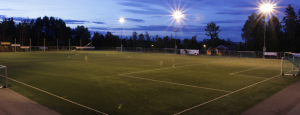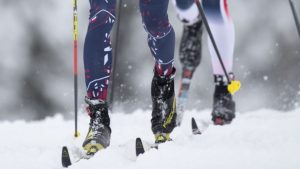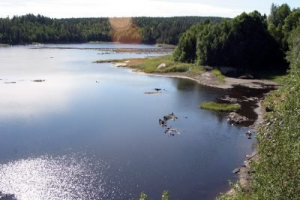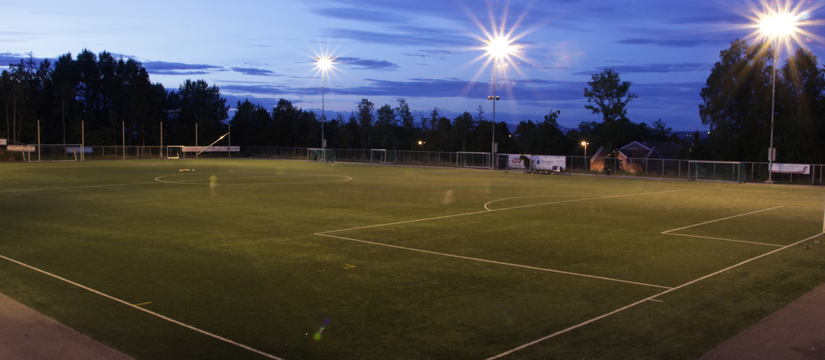By Ludvig Bruusgaard Torsvik and Trygve Lien Kjølseth.
People on Nesodden enjoy outdoor activities and experiencing the beautiful Norwegian nature. How does this affect the water quality and biodiversity of lakes, streams and fjords?
We can start with the different artificial turfs in Nesodden. The soccer fields we make here in Norway is an artificial turf filled with small pieces of rubber. These rubber pieces are put there to give better cushioning but can also hurt the environment and the biodiversity where we live and in our oceans.

In an interview with Ellen Lien who worked with environmental protection here in Nesodden we asked her these questions:
Where does the rubber pieces from the artificial soccer fields end up?
- They can end up in the forests close to the soccer fields and can get washed into our oceans by the rains and our rivers. On a more trivial note, they can be quite annoying too, because the get into socks and shoes and get brought home.
How can we try to stop the spreading of the rubber pieces?
- One thing you can do to prevent the spreading is making a physical barrier, like a wall or a moat to collect them. Another thing you can do is being more careful when we plough snow away from the field as the snow is often filled with the rubber pieces.
Ellen Lien answered that physical barriers could be set up, a proposal that the Ministry of Climate and Environment also has come with. According to the Ministry of Climate and Environment, barriers could reduce emissions of artificial grass knots by up to 98%.
What can be consequence of the small rubber piece spreading?
- Streams and rivers can transport the rubber pieces to lakes and our oceans.
There it will pollute the water and possibly be eaten by birds and fish for which, in the worst case, can be fatal.
In the winter there’s usually is a thick layer of snow in Nesodden. This means there’s also good skiing opportunities.
We asked Ellen a few questions about the fluoride in the ski track which there is plenty of roundabout in Nesodden. Fluoride is a substance which they out in all sorts of products, mainly toothpaste but also in thing like ski waxes. When you are out skiing the wax will eventually fall off bit by bit which leaves trace amounts of fluoride in the ski tracks.

Many companies add fluoride to their ski waxes, does this mean that there is more fluoride in the ground than around ski tracks than other places?
- I don’t know, and I don’t think they have measured, but other places measures show that earthworms that live around ski tracks have very high amounts of fluoride.
What can the consequences of too high fluorite value be?
- Fluorite is poisonous, it builds up in the food chain and makes animals potentially fatal ill. Fluorite also makes heavy metal build up in the body easier.
The answer was found on Dagbladet, a Norwegian newspaper.
There are many other ways our water can be contaminated. One thing that can
 be potentially dangerous is faecal matter in our drinking water. It is very rare that faecally contaminated water gets through unpurified but faecal matter can seep through the water transportation pipes if they get damaged.
be potentially dangerous is faecal matter in our drinking water. It is very rare that faecally contaminated water gets through unpurified but faecal matter can seep through the water transportation pipes if they get damaged.
Many people walk their dog or ride horses around our nearest lake and water supply, the Blekslitjern. Their animal’s faeces may get into our water, what can the consequences of this be?
Bacteria from the faeces may get into our water and can make us seriously ill.
What can you do to prevent this?
Inform people by setting up signs in the catchment area to Blekslitjern. if they have problems with people taking baths in Blekslitjern, they can do as they did in Maridalsvannet in Oslo and put up fences.
Faecal contamination is not very dangerous unless it’s very severe or it is seeping into waterpipes after the water has been purified. In question 2 Ellen says that in some drinking water lakes, people are taking baths, this is not a problem at Blekslitjern.
https://www.dagbladet.no/sport/skremt-av-fluorfunn-i-granasen/71780184
https://www.dagbladet.no/sport/loypene-er-forgiftet/71918053
https://www.fhi.no/nettpub/stoffer-i-drikkevann/om-stoffer-i-drikkevann/om-stoffer-i-drikkevann/
